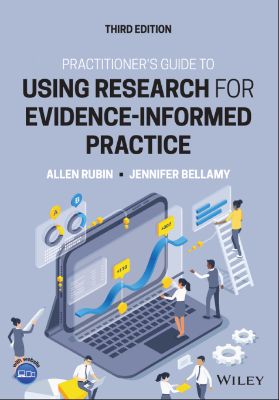Practitioner's Guide to Using Research for Evidence-Informed Practice

Námskeið
- FSG0112 Fræðileg skrif og gagnreynt starf
Lýsing:
The latest edition of an essential text to help students and practitioners distinguish between research studies that should and should not influence practice decisions Now in its third edition, Practitioner's Guide to Using Research for Evidence-Informed Practice delivers an essential and practical guide to integrating research appraisal into evidence-informed practice. The book walks you through the skills, knowledge, and strategies you can use to identify significant strengths and limitations in research.
The ability to appraise the veracity and validity of research will improve your service provision and practice decisions. By teaching you to be a critical consumer of modern research, this book helps you avoid treatments based on fatally flawed research and methodologies. Practitioner's Guide to Using Research for Evidence-Informed Practice, Third Edition offers: An extensive introduction to evidence-informed practice, including explorations of unethical research and discussions of social justice in the context of evidence-informed practice.
Explanations of how to appraise studies on intervention efficacy, including the criteria for inferring effectiveness and critically examining experiments. Discussions of how to critically appraise studies for alternative evidence-informed practice questions, including nonexperimental quantitative studies and qualitative studies. A comprehensive and authoritative blueprint for critically assessing research studies, interventions, programs, policies, and assessment tools, Practitioner's Guide to Using Research for Evidence-Informed Practice belongs in the bookshelves of students and practitioners of the social sciences.
Annað
- Höfundar: Allen Rubin, Jennifer Bellamy
- Útgáfa:3
- Útgáfudagur: 2022-03-08
- Hægt að prenta út 10 bls.
- Hægt að afrita 2 bls.
- Format:ePub
- ISBN 13: 9781119858584
- Print ISBN: 9781119858560
- ISBN 10: 1119858585
Efnisyfirlit
- COVER
- TITLE PAGE
- COPYRIGHT
- PREFACE
- Organization and Special Features
- Significant Additions to This Edition
- ACKNOWLEDGEMENTS
- ABOUT THE AUTHORS
- ABOUT THE COMPANION WEBSITE
- PART 1: OVERVIEW OF EVIDENCE-INFORMED PRACTICE
- 1 Introduction to Evidence-Informed Practice (EIP)
- 1.1 Emergence of EIP
- 1.2 Defining EIP
- 1.3 Types of EIP Questions
- 1.4 EIP Practice Regarding Policy and Social Justice
- 1.5 EIP and Black Lives Matter
- 1.6 Developing an EIP Practice Process Outlook
- 1.7 EIP as a Client-Centered, Compassionate Means, Not an End unto Itself
- 1.8 EIP and Professional Ethics
- Key Chapter Concepts
- Additional Reading
- 2 Steps in the EIP Process
- 2.1 Step 1: Question Formulation
- 2.2 Step 2: Evidence Search
- 2.3 Step 3: Critically Appraising Studies and Reviews
- 2.4 Step 4: Selecting and Implementing the Intervention
- 2.5 Step 5: Monitor Client Progress
- 2.6 Feasibility Constraints
- 2.7 But What about the Dodo Bird Verdict?
- Key Chapter Concepts
- Additional Reading
- 3 Research Hierarchies: Which Types of Research Are Best for Which Questions?
- 3.1 More than One Type of Hierarchy for More than One Type of EIP Question
- 3.2 Qualitative and Quantitative Studies
- 3.3 Which Types of Research Designs Apply to Which Types of EIP Questions?
- Key Chapter Concepts
- Additional Reading
- 1 Introduction to Evidence-Informed Practice (EIP)
- 4 Criteria for Inferring Effectiveness: How Do We Know What Works?
- 4.1 Internal Validity
- 4.2 Measurement Issues
- 4.3 Statistical Chance
- 4.4 External Validity
- 4.5 Synopses of Fictitious Research Studies
- Key Chapter Concepts
- Exercise for Critically Appraising Published Articles
- Additional Reading
- 5 Critically Appraising Experiments
- 5.1 Classic Pretest-Posttest Control Group Design
- 5.2 Posttest-Only Control Group Design
- 5.3 Solomon Four-Group Design
- 5.4 Alternative Treatment Designs
- 5.5 Dismantling Designs
- 5.6 Placebo Control Group Designs
- 5.7 Experimental Demand and Experimenter Expectancies
- 5.8 Obtrusive Versus Unobtrusive Observation
- 5.9 Compensatory Equalization and Compensatory Rivalry
- 5.10 Resentful Demoralization
- 5.11 Treatment Diffusion
- 5.12 Treatment Fidelity
- 5.13 Practitioner Equivalence
- 5.14 Differential Attrition
- 5.15 Synopses of Research Studies
- Key Chapter Concepts
- Exercise for Critically Appraising Published Articles
- Additional Reading
- 6 Critically Appraising Quasi-Experiments: Nonequivalent Comparison Groups Designs
- 6.1 Nonequivalent Comparison Groups Designs
- 6.2 Additional Logical Arrangements to Control for Potential Selectivity Biases
- 6.3 Statistical Controls for Potential Selectivity Biases
- 6.4 Creating Matched Comparison Groups Using Propensity Score Matching
- 6.5 Pilot Studies
- 6.6 Synopses of Research Studies
- Key Chapter Concepts
- Exercise for Critically Appraising Published Articles
- Additional Reading
- 7 Critically Appraising Quasi-Experiments: Time-Series Designs and Single-Case Designs
- 7.1 Simple Time-Series Designs
- 7.2 Multiple Time-Series Designs
- 7.3 Single-Case Designs
- 7.4 Synopses of Research Studies
- Key Chapter Concepts
- Exercise for Critically Appraising Published Articles
- Additional Reading
- 8 Critically Appraising Systematic Reviews and Meta-Analyses
- 8.1 Advantages of Systematic Reviews and Meta-Analyses
- 8.2 Risks in Relying Exclusively on Systematic Reviews and Meta-Analyses
- 8.3 Where to Start
- 8.4 What to Look for When Critically Appraising Systematic Reviews
- 8.5 What Distinguishes a Systematic Review from Other Types of Reviews?
- 8.6 What to Look for When Critically Appraising Meta-Analyses
- 8.7 Synopses of Research Studies
- Key Chapter Concepts
- Exercise for Critically Appraising Published Articles
- Additional Reading
- 9 Critically Appraising Nonexperimental Quantitative Studies
- 9.1 Surveys
- 9.2 Cross-Sectional and Longitudinal Studies
- 9.3 Case-Control Studies
- 9.4 Synopses of Research Studies
- Key Chapter Concepts
- Exercise for Critically Appraising Published Articles
- Additional Reading
- 10 Critically Appraising Qualitative Studies
- 10.1 Qualitative Observation
- 10.2 Qualitative Interviewing
- 10.3 Other Qualitative Methodologies
- 10.4 Qualitative Sampling
- 10.5 Grounded Theory
- 10.6 Alternatives to Grounded Theory
- 10.7 Frameworks for Appraising Qualitative Studies
- 10.8 Mixed Model and Mixed Methods Studies
- 10.9 Synopses of Research Studies
- Key Chapter Concepts
- Exercise for Critically Appraising Published Articles
- Additional Reading
- 11 Critically Appraising, Selecting, and Constructing Assessment Instruments
- 11.1 Reliability
- 11.2 Validity
- 11.3 Feasibility
- 11.4 Sample Characteristics
- 11.5 Locating Assessment Instruments
- 11.6 Constructing Assessment Instruments
- 11.7 Synopses of Research Studies
- Key Chapter Concepts
- Exercise for Critically Appraising Published Articles
- Additional Reading
- 12 Monitoring Client Progress
- 12.1 A Practitioner-Friendly Single-Case Design
- 12.2 Using Within-Group Effect-Size Benchmarks
- Key Chapter Concepts
- Additional Reading
- 13 Appraising and Conducting Data Analyses in EIP
- 13.1 Introduction
- 13.2 Ruling Out Statistical Chance
- 13.3 What Else Do You Need to Know?
- 13.4 The 05 Cutoff Point Is Not Sacred!
- 13.5 What Else Do You Need to Know?
- 13.6 Calculating Within-Group Effect Sizes and Using Benchmarks
- 13.7 Conclusion
- Key Chapter Concepts
- Additional Reading
- 14 Critically Appraising Social Justice Research Studies
- 14.1 Introduction
- 14.2 Evidence-Informed Social Action
- 14.3 What Type of Evidence?
- 14.4 Participatory Action Research (PAR)
- 14.5 Illustrations of Other Types of Social Justice Research
- 14.6 Conclusion
- Key Chapter Concepts
- Additional Reading
- Note
UM RAFBÆKUR Á HEIMKAUP.IS
Bókahillan þín er þitt svæði og þar eru bækurnar þínar geymdar. Þú kemst í bókahilluna þína hvar og hvenær sem er í tölvu eða snjalltæki. Einfalt og þægilegt!Rafbók til eignar
Rafbók til eignar þarf að hlaða niður á þau tæki sem þú vilt nota innan eins árs frá því bókin er keypt.
Þú kemst í bækurnar hvar sem er
Þú getur nálgast allar raf(skóla)bækurnar þínar á einu augabragði, hvar og hvenær sem er í bókahillunni þinni. Engin taska, enginn kyndill og ekkert vesen (hvað þá yfirvigt).
Auðvelt að fletta og leita
Þú getur flakkað milli síðna og kafla eins og þér hentar best og farið beint í ákveðna kafla úr efnisyfirlitinu. Í leitinni finnur þú orð, kafla eða síður í einum smelli.
Glósur og yfirstrikanir
Þú getur auðkennt textabrot með mismunandi litum og skrifað glósur að vild í rafbókina. Þú getur jafnvel séð glósur og yfirstrikanir hjá bekkjarsystkinum og kennara ef þeir leyfa það. Allt á einum stað.
Hvað viltu sjá? / Þú ræður hvernig síðan lítur út
Þú lagar síðuna að þínum þörfum. Stækkaðu eða minnkaðu myndir og texta með multi-level zoom til að sjá síðuna eins og þér hentar best í þínu námi.
Fleiri góðir kostir
- Þú getur prentað síður úr bókinni (innan þeirra marka sem útgefandinn setur)
- Möguleiki á tengingu við annað stafrænt og gagnvirkt efni, svo sem myndbönd eða spurningar úr efninu
- Auðvelt að afrita og líma efni/texta fyrir t.d. heimaverkefni eða ritgerðir
- Styður tækni sem hjálpar nemendum með sjón- eða heyrnarskerðingu
- Gerð : 208
- Höfundur : 11417
- Útgáfuár : 2012
- Leyfi : 379


